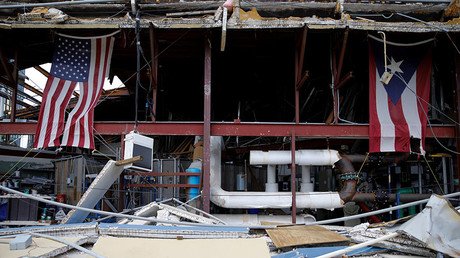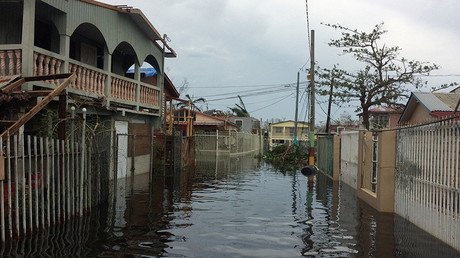Puerto Rico could face 6 months without power

After Puerto Rico was pummeled by Hurricane Maria last week, a Category 4 hurricane with 150 mph winds, the island has been left in shambles. After suffering widespread power outages thanks to Irma, one million Puerto Ricans were left without electricity. 60,000 still hadn’t gotten power when Maria brought a total, island-wide power outage and severe shortages in food, water, and other supplies.
As of today there’s still no power on the island except for a handful of generators powering high-priority buildings like select hospitals, and the island likely won’t return to full power for another half a year. This also means that there are next to zero working cell phone towers and no reception anywhere on the island.
Due to the blackout, many residents are relying on small gas-fed generators, and fuel is running out (though authorities in Puerto Rico insist that it’s a distribution problem, not a shortage). Puerto Ricans are waiting in six-hour lines for fuel, while many stations have run completely dry.
In most of Puerto Rico there’s no water either - that means no showers, no flushable toilets, and no drinkable water that’s not out of a bottle. In some of the remoter parts of the island, rescue workers are just barely beginning to arrive.
Puerto Rico is experiencing all of the normal catastrophes brought on by a major hurricane - and then some. In Houston after Harvey and Florida after Irma, wastewater pumping systems failed, causing significant sewage spillage. The same is almost guaranteed to happen in Puerto Rico thanks to the sustained power outages, but will be greatly exacerbated by the fact that the island’s electrical system was already “degraded and unsafe”.
READ MORE: Hurricane Maria leaves Puerto Rico ‘100% without power’
In fact, nearly every problem typically faced in the wake of natural disaster will be amplified and accelerated in Puerto Rico thanks to long-existing financial and environmental problems and far fewer rescue and relief workers.
Florida and Texas also dealt with contamination from Superfund sites, but Puerto Rico has a whopping 23 in its relatively tiny area.
According to the US Department of Health and Public Services, a superfund site is “any land in the United States that has been contaminated by hazardous waste and identified by the EPA as a candidate for cleanup because it poses a risk to human health and/or the environment.” These sites are put on the National Priorities List (NPL), a list of the most dire cases of environmental contamination in the US and its territories. These are places where a person can’t even walk on the ground and breathe the air without seriously endangering their health.
Even within the designation of Superfund, sites can be ranked in their level of catastrophism, and Puerto Rico is home to one of the very worst. For sixty years the US military used Vieques, an outlying island, for extensive bomb testing. Two thirds of the island now have extreme levels of contamination which have been related to disproportionately high cancer rates among the 9,000 residents. Even today Vieques remains blanketed with unexploded bombs, bullets, and projectiles.
Puerto Rico also has more contaminants to worry about thanks to the coal industry, which has been stockpiling coal ash in southern Puerto Rico. According to Adriana Gonzales of the Sierra Club, an uncovered five-story pile of coal ash situated next to a low-income and minority community in the town of Guayama threatens to toxify the entire area thanks to its content of heavy metals like arsenic, mercury, and chromium that will be released when the rain liquefies the ash.
The coal industry also dumped thousands of tons of coal ash in Puerto Rican landfills for years, a common practice that has recently mushroomed into a disaster as local landfills overflow thanks to the territory’s financial crisis. While the ash is not Puerto Rico’s (it’s owned by Pennsylvania-based Applied Energy Systems) they are now faced with its toxic burden, despite the fact that the Puerto Rican government ordered the company to cover and secure the pile under the threat of Hurricane Irma, weeks before Maria hit.
Puerto Rico’s fallout of Maria will result in a long, long road to recovery. Even though the island is home to 3.5 million US citizens, help is few and far between compared to response in the US, and the island’s pre-existing poverty and environmentally dangerous Superfund Sites will make rebuilding a tricky and toxic business, costing in the billions of dollars.
This article was originally published on Oilprice.com














